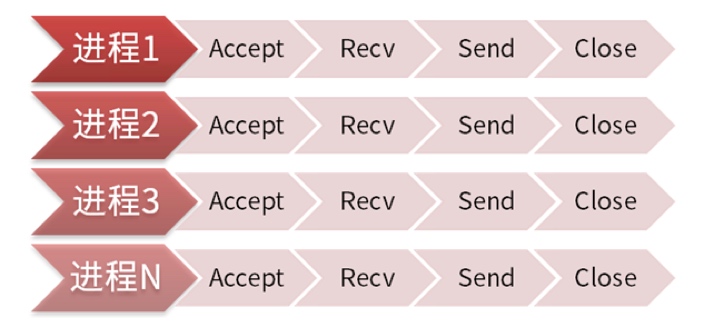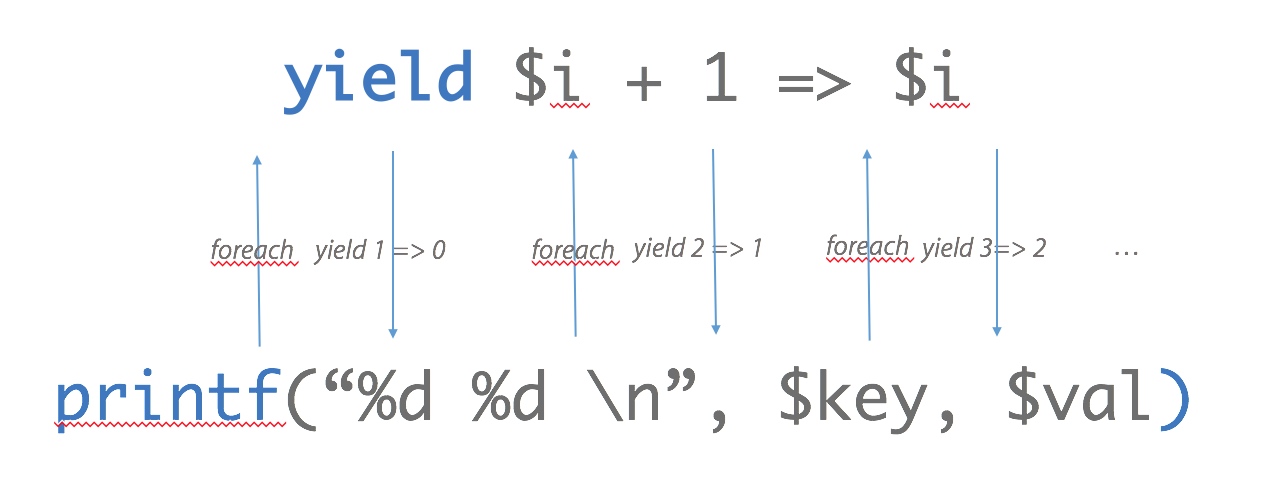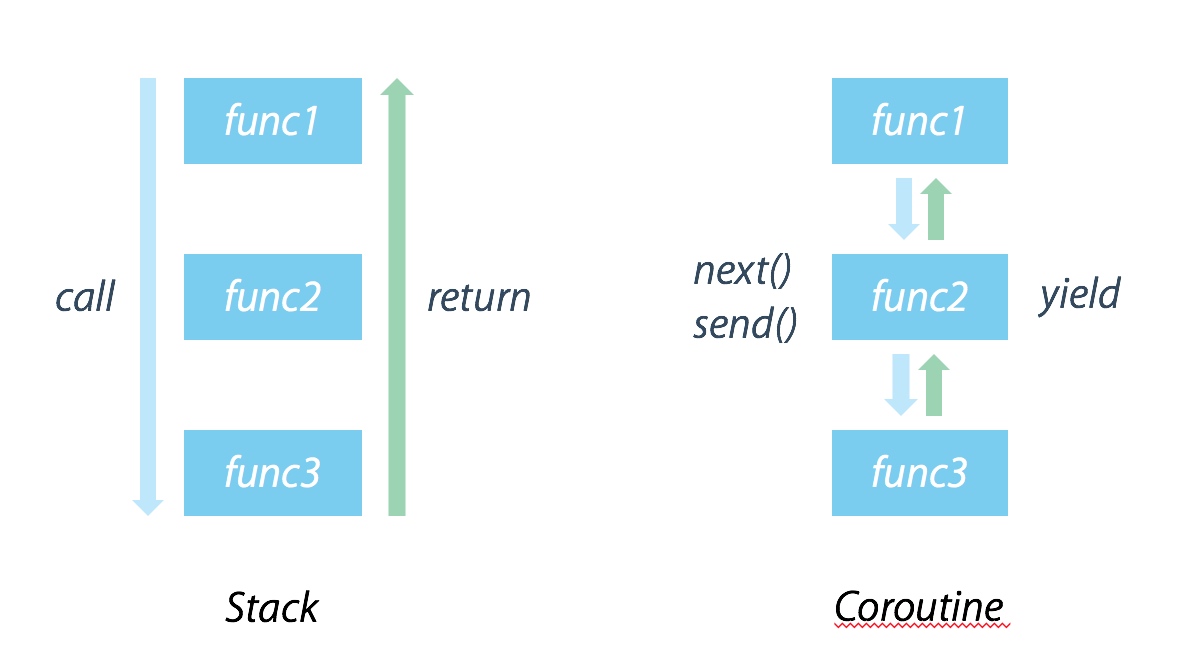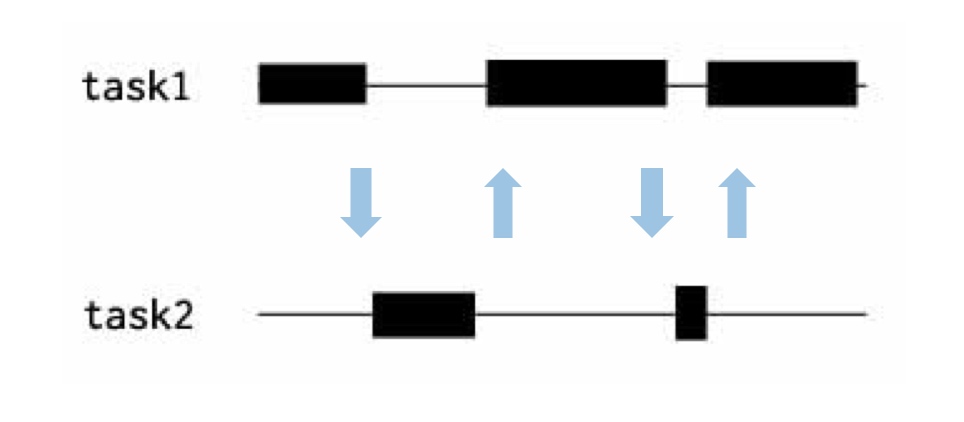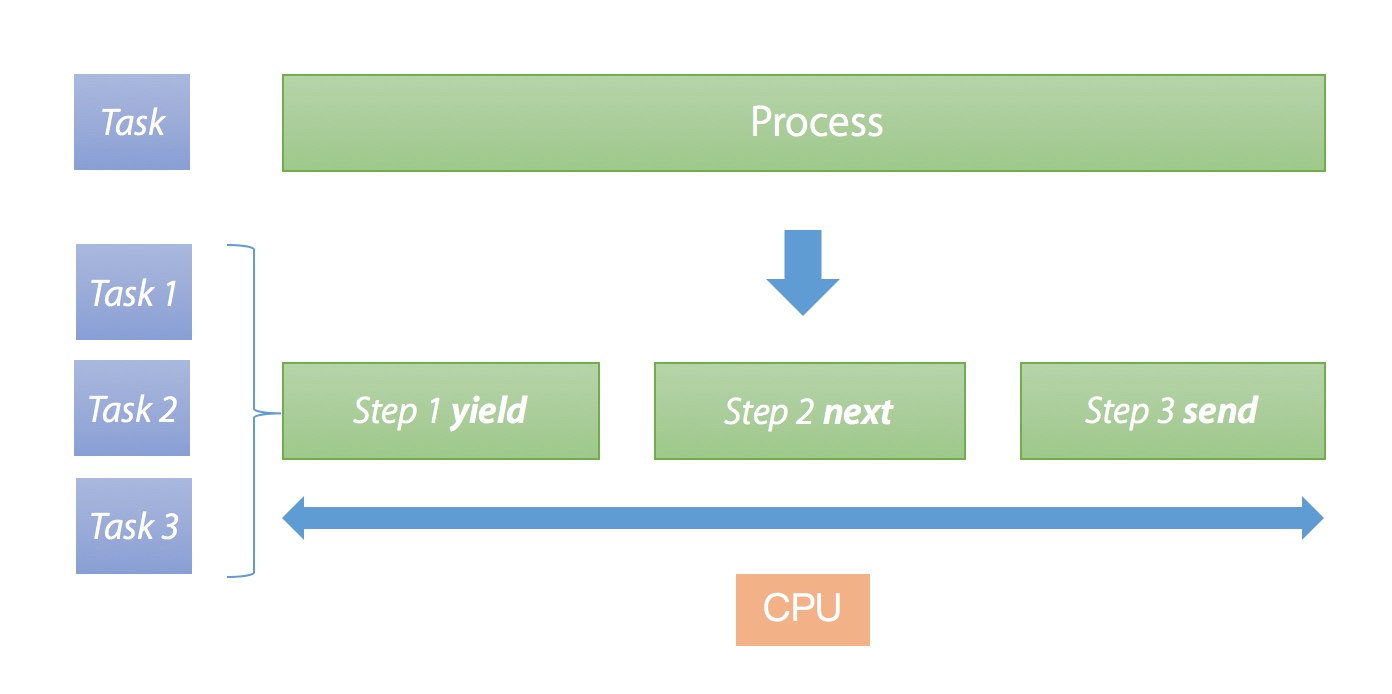实现 PHP 协程需要了解的基本内容。
多进程/线程 最早的服务器端程序都是通过多进程、多线程来解决并发IO的问题。进程模型出现的最早,从Unix 系统诞生就开始有了进程的概念。最早的服务器端程序一般都是 Accept 一个客户端连接就创建一个进程,然后子进程进入循环同步阻塞地与客户端连接进行交互,收发处理数据。
多线程模式出现要晚一些,线程与进程相比更轻量,而且线程之间共享内存堆栈,所以不同的线程之间交互非常容易实现。比如实现一个聊天室,客户端连接之间可以交互,聊天室中的玩家可以任意的其他人发消息。用多线程模式实现非常简单,线程中可以直接向某一个客户端连接发送数据。而多进程模式就要用到管道、消息队列、共享内存等等统称进程间通信(IPC)复杂的技术才能实现。
最简单的多进程服务端模型
1
2
3
4
5
6
7
8
9
10
11
12
13
14
$serv = stream_socket_server("tcp://0.0.0.0:8000" , $errno, $errstr)
or die ("Create server failed" );
while (1 ) {
$conn = stream_socket_accept($serv);
if (pcntl_fork() == 0 ) {
$request = fread($conn);
fwrite($response);
fclose($conn);
exit (0 );
}
}
多进程/线程模型的流程是:
创建一个 socket,绑定服务器端口(bind),监听端口(listen),在 PHP 中用 stream_socket_server 一个函数就能完成上面 3 个步骤,当然也可以使用更底层的sockets 扩展分别实现。
进入 while 循环,阻塞在 accept 操作上,等待客户端连接进入。此时程序会进入睡眠状态,直到有新的客户端发起 connect 到服务器,操作系统会唤醒此进程。accept 函数返回客户端连接的 socket 主进程在多进程模型下通过 fork(php: pcntl_fork)创建子进程,多线程模型下使用 pthread_create(php: new Thread)创建子线程。
下文如无特殊声明将使用进程同时表示进程/线程。
子进程创建成功后进入 while 循环,阻塞在 recv(php:fread)调用上,等待客户端向服务器发送数据。收到数据后服务器程序进行处理然后使用 send(php: fwrite)向客户端发送响应。长连接的服务会持续与客户端交互,而短连接服务一般收到响应就会 close。
当客户端连接关闭时,子进程退出并销毁所有资源,主进程会回收掉此子进程。
这种模式最大的问题是,进程创建和销毁的开销很大。所以上面的模式没办法应用于非常繁忙的服务器程序。对应的改进版解决了此问题,这就是经典的 Leader-Follower 模型。
1
2
3
4
5
6
7
8
9
10
11
12
13
14
15
16
17
$serv = stream_socket_server("tcp://0.0.0.0:8000" , $errno, $errstr)
or die ("Create server failed" );
for ($i = 0 ; $i < 32 ; $i++) {
if (pcntl_fork() == 0 ) {
while (1 ) {
$conn = stream_socket_accept($serv);
if ($conn == false ) continue ;
$request = fread($conn);
fwrite($response);
fclose($conn);
}
exit (0 );
}
}
它的特点是程序启动后就会创建 N 个进程。每个子进程进入 Accept,等待新的连接进入。当客户端连接到服务器时,其中一个子进程会被唤醒,开始处理客户端请求,并且不再接受新的 TCP 连接。当此连接关闭时,子进程会释放,重新进入 Accept,参与处理新的连接。
这个模型的优势是完全可以复用进程,没有额外消耗,性能非常好。很多常见的服务器程序都是基于此模型的,比如 Apache、PHP-FPM。
多进程模型也有一些缺点。
这种模型严重依赖进程的数量解决并发问题,一个客户端连接就需要占用一个进程,工作进程的数量有多少,并发处理能力就有多少。操作系统可以创建的进程数量是有限的。
启动大量进程会带来额外的进程调度消耗。数百个进程时可能进程上下文切换调度消耗占 CPU 不到 1% 可以忽略不计,如果启动数千甚至数万个进程,消耗就会直线上升。调度消耗可能占到 CPU 的百分之几十甚至 100%。
并行和并发 谈到多进程以及类似同时执行多个任务的模型,就不得不先谈谈并行和并发。
并发(Concurrency) 是指能处理多个同时活动的能力,并发事件之间不一定要同一时刻发生。
并行(Parallesim) 是指同时刻发生的两个并发事件,具有并发的含义,但并发不一定并行。
区别
『并发』指的是程序的结构,『并行』指的是程序运行时的状态
『并行』一定是并发的,『并行』是『并发』设计的一种
单线程永远无法达到『并行』状态
正确的并发设计的标准是:
使多个操作可以在重叠的时间段内进行。
参考:
迭代器 & 生成器 在了解 PHP 协程前,还有 迭代器 和 生成器 这两个概念需要先认识一下。
迭代器 PHP5 开始内置了 Iterator 即迭代器接口,所以如果你定义了一个类,并实现了Iterator 接口,那么你的这个类对象就是 ZEND_ITER_OBJECT 即可迭代的,否则就是 ZEND_ITER_PLAIN_OBJECT。
对于 ZEND_ITER_PLAIN_OBJECT 的类,foreach 会获取该对象的默认属性数组,然后对该数组进行迭代。
而对于 ZEND_ITER_OBJECT 的类对象,则会通过调用对象实现的 Iterator 接口相关函数来进行迭代。
任何实现了 Iterator 接口的类都是可迭代的 ,即都可以用 foreach 语句来遍历。
Iterator 接口 1
2
3
4
5
6
7
8
9
10
11
12
13
14
15
16
17
interface Iterator extends Traversable
{
public mixed current()
public scalar key()
public void next()
public void rewind()
public boolean valid()
}
常规实现 range 函数 PHP 自带的 range 函数原型:
range — 根据范围创建数组,包含指定的元素
array range (mixed $start , mixed $end [, number $step = 1 ])
建立一个包含指定范围单元的数组。
在不使用迭代器的情况要实现一个和 PHP 自带的 range 函数类似的功能,可能会这么写:
1
2
3
4
5
6
7
8
9
10
function range ($start, $end, $step = 1 )
{
$ret = [];
for ($i = $start; $i <= $end; $i += $step) {
$ret[] = $i;
}
return $ret;
}
需要将生成的所有元素放在内存数组中,如果需要生成一个非常大的集合,则会占用巨大的内存。
迭代器实现 xrange 函数 来看看迭代实现的 range,我们叫做 xrange,他实现了 Iterator 接口必须的 5 个方法:
1
2
3
4
5
6
7
8
9
10
11
12
13
14
15
16
17
18
19
20
21
22
23
24
25
26
27
28
29
30
31
32
33
34
35
36
37
38
39
class Xrange implements Iterator
{
protected $start;
protected $limit;
protected $step;
protected $current;
public function __construct ($start, $limit, $step = 1 )
{
$this ->start = $start;
$this ->limit = $limit;
$this ->step = $step;
}
public function rewind ()
{
$this ->current = $this ->start;
}
public function next ()
{
$this ->current += $this ->step;
}
public function current ()
{
return $this ->current;
}
public function key ()
{
return $this ->current + 1 ;
}
public function valid ()
{
return $this ->current <= $this ->limit;
}
}
使用时代码如下:
1
2
3
foreach (new Xrange(0 , 9 ) as $key => $val) {
echo $key, ' ' , $val, "\n" ;
}
输出:
1
2
3
4
5
6
7
8
9
10
0 0
1 1
2 2
3 3
4 4
5 5
6 6
7 7
8 8
9 9
看上去功能和 range() 函数所做的一致,不同点在于迭代的是一个 对象(Object) 而不是数组:
1
var_dump(new Xrange(0 , 9 ));
输出:
1
2
3
4
5
6
7
8
9
10
object(Xrange)#1 (4) {
["start":protected]=>
int(0)
["limit":protected]=>
int(9)
["step":protected]=>
int(1)
["current":protected]=>
NULL
}
另外,内存的占用情况也完全不同:
1
2
3
4
5
6
7
8
9
10
11
$startMemory = memory_get_usage();
$arr = range(0 , 500000 );
echo 'range(): ' , memory_get_usage() - $startMemory, " bytes\n" ;
unset ($arr);
$startMemory = memory_get_usage();
$arr = new Xrange(0 , 500000 );
echo 'xrange(): ' , memory_get_usage() - $startMemory, " bytes\n" ;
输出:
1
2
xrange(): 624 bytes
range(): 72194784 bytes
range() 函数在执行后占用了 50W 个元素内存空间,而 xrange 对象在整个迭代过程中只占用一个对象的内存。
Yii2 Query 在喜闻乐见的各种 PHP 框架里有不少生成器的实例,比如 Yii2 中用来构建 SQL 语句的 \yii\db\Query 类:
1
2
3
4
5
$query = (new \yii\db\Query)->from('user' );
foreach ($query->batch() as $users) {
}
来看一下 batch() 做了什么:
1
2
3
4
5
6
7
8
9
10
11
12
13
14
15
16
17
18
19
20
21
22
23
24
25
26
27
28
29
30
31
* Starts a batch query.
*
* A batch query supports fetching data in batches, which can keep the memory usage under a limit.
* This method will return a [[BatchQueryResult]] object which implements the [[\Iterator]] interface
* and can be traversed to retrieve the data in batches.
*
* For example,
*
*
* $query = (new Query)->from('user');
* foreach ($query->batch() as $rows) {
* // $rows is an array of 10 or fewer rows from user table
* }
*
*
* @param integer $batchSize the number of records to be fetched in each batch.
* @param Connection $db the database connection. If not set, the "db" application component will be used.
* @return BatchQueryResult the batch query result. It implements the [[\Iterator]] interface
* and can be traversed to retrieve the data in batches.
*/
public function batch ($batchSize = 100 , $db = null)
{
return Yii::createObject([
'class' => BatchQueryResult::className(),
'query' => $this ,
'batchSize' => $batchSize,
'db' => $db,
'each' => false ,
]);
}
实际上返回了一个 BatchQueryResult 类,类的源码实现了 Iterator 接口 5 个关键方法:
1
2
3
4
5
6
7
8
9
10
11
12
13
14
15
16
17
18
19
20
21
22
23
24
25
26
27
28
29
30
31
32
33
34
35
36
37
38
39
40
41
42
43
44
45
46
47
48
49
50
51
52
53
54
55
56
57
58
59
60
61
62
63
64
65
66
67
68
69
70
71
72
73
74
75
76
77
78
79
80
81
82
83
84
85
86
87
88
89
90
91
92
93
94
95
96
97
98
99
100
101
102
103
104
105
106
107
108
109
110
111
class BatchQueryResult extends Object implements \Iterator
{
public $db;
public $query;
public $batchSize = 100 ;
public $each = false ;
private $_dataReader;
private $_batch;
private $_value;
private $_key;
* Destructor.
*/
public function __destruct ()
{
$this ->reset();
}
* Resets the batch query.
* This method will clean up the existing batch query so that a new batch query can be performed.
*/
public function reset ()
{
if ($this ->_dataReader !== null ) {
$this ->_dataReader->close();
}
$this ->_dataReader = null ;
$this ->_batch = null ;
$this ->_value = null ;
$this ->_key = null ;
}
* Resets the iterator to the initial state.
* This method is required by the interface [[\Iterator]].
*/
public function rewind ()
{
$this ->reset();
$this ->next();
}
* Moves the internal pointer to the next dataset.
* This method is required by the interface [[\Iterator]].
*/
public function next ()
{
if ($this ->_batch === null || !$this ->each || $this ->each && next($this ->_batch) === false ) {
$this ->_batch = $this ->fetchData();
reset($this ->_batch);
}
if ($this ->each) {
$this ->_value = current($this ->_batch);
if ($this ->query->indexBy !== null ) {
$this ->_key = key($this ->_batch);
} elseif (key($this ->_batch) !== null ) {
$this ->_key++;
} else {
$this ->_key = null ;
}
} else {
$this ->_value = $this ->_batch;
$this ->_key = $this ->_key === null ? 0 : $this ->_key + 1 ;
}
}
* Fetches the next batch of data.
* @return array the data fetched
*/
protected function fetchData ()
{
}
* Returns the index of the current dataset.
* This method is required by the interface [[\Iterator]].
* @return integer the index of the current row.
*/
public function key ()
{
return $this ->_key;
}
* Returns the current dataset.
* This method is required by the interface [[\Iterator]].
* @return mixed the current dataset.
*/
public function current ()
{
return $this ->_value;
}
* Returns whether there is a valid dataset at the current position.
* This method is required by the interface [[\Iterator]].
* @return boolean whether there is a valid dataset at the current position.
*/
public function valid ()
{
return !empty ($this ->_batch);
}
}
以迭代器的方式实现了类似分页取的效果,同时避免了一次性取出所有数据占用太多的内存空间。
迭代器使用场景
使用返回迭代器的包或库时(如 PHP5 中的 SPL 迭代器)
无法在一次调用获取所需的所有元素时
要处理数量巨大的元素时(数据库中要处理的结果集内容超过内存)
…
生成器 需要 PHP 5 >= 5.5.0 或 PHP 7
虽然迭代器仅需继承接口即可实现,但毕竟需要定义一整个类然后实现接口的所有方法,实在是不怎么方便。
生成器则提供了一种更简单的方式来实现简单的对象迭代,相比定义类来实现 Iterator 接口的方式,性能开销和复杂度大大降低。
生成器允许在 foreach 代码块中迭代一组数据而不需要创建任何数组。一个生成器函数,就像一个普通的有返回值的自定义函数类似,但普通函数只返回一次, 而生成器可以根据需要通过 yield 关键字返回多次,以便连续生成需要迭代返回的值。
一个最简单的例子就是使用生成器来重新实现 xrange() 函数。效果和上面我们用迭代器实现的差不多,但实现起来要简单的多。
生成器实现 xrange 函数 1
2
3
4
5
6
7
8
9
10
11
12
13
14
15
16
17
18
19
20
function xrange ($start, $limit, $step = 1 )
for ($i = 0 ; $i < $limit; $i += $step) {
yield $i + 1 => $i;
}
}
foreach (xrange(0 , 9 ) as $key => $val) {
printf("%d %d \n" , $key, $val);
}
实际上生成器生成的正是一个迭代器对象实例,该迭代器对象继承了 Iterator 接口,同时也包含了生成器对象自有的接口,具体可以参考 Generator 类的定义以及语法参考 。
同时需要注意的是:
yield 关键字 需要注意的是 yield 关键字,这是生成器的关键。通过上面的例子可以看出,yield 会将当前产生的值传递给 foreach,换句话说,foreach 每一次迭代过程都会从 yield 处取一个值,直到整个遍历过程不再能执行到 yield 时遍历结束,此时生成器函数简单的退出,而调用生成器的上层代码还可以继续执行,就像一个数组已经被遍历完了。
yield 最简单的调用形式看起来像一个 return 申明,不同的是 yield 暂停当前过程的执行并返回值,而 return 是中断当前过程并返回值。暂停当前过程,意味着将处理权转交由上一级继续进行,直到上一级再次调用被暂停的过程,该过程又会从上一次暂停的位置继续执行。这像是什么呢?如果之前已经在鸟哥的文章 中粗略看过,应该知道这很像操作系统的进程调度,多个进程在一个 CPU 核心上执行,在系统调度下每一个进程执行一段指令就被暂停,切换到下一个进程,这样外部用户看起来就像是同时在执行多个任务。
但仅仅如此还不够,yield 除了可以返回值以外,还能接收值,也就是可以在两个层级间实现双向通信 。
来看看如何传递一个值给 yield:
1
2
3
4
5
6
7
8
9
10
11
12
13
14
15
function printer ()
{
while (true ) {
printf("receive: %s\n" , yield );
}
}
$printer = printer();
$printer->send('hello' );
$printer->send('world' );
receive: hello
receive: world
根据 PHP 官方文档 的描述可以知道 Generator 对象除了实现 Iterator 接口中的必要方法以外,还有一个 send 方法,这个方法就是向 yield 语句处传递一个值,同时从 yield 语句处继续执行,直至再次遇到 yield 后控制权回到外部。
既然 yield 可以在其位置中断并返回或者接收一个值,那能不能同时进行接收 和返回 呢?当然,这也是实现协程的根本。对上述代码做出修改:
1
2
3
4
5
6
7
8
9
10
11
12
13
14
15
16
17
18
19
20
21
22
function printer ()
{
$i = 0 ;
while (true ) {
printf("receive: %s\n" , (yield ++$i));
}
}
$printer = printer();
printf("%d\n" , $printer->current());
$printer->send('hello' );
printf("%d\n" , $printer->current());
$printer->send('world' );
printf("%d\n" , $printer->current());
1
receive: hello
2
receive: world
3
这是另一个例子:
1
2
3
4
5
6
7
8
9
10
11
12
13
function gen ()
$ret = (yield 'yield1' );
var_dump($ret);
$ret = (yield 'yield2' );
var_dump($ret);
}
$gen = gen();
var_dump($gen->current());
var_dump($gen->send('ret1' ));
var_dump($gen->send('ret2' ));
current 方法是迭代器 Iterator 接口必要的方法,foreach 语句每一次迭代都会通过其获取当前值,而后调用迭代器的 next 方法。在上述例子里则是手动调用了 current 方法获取值。
上述例子已经足以表示 yield 能够作为实现双向通信的工具,也就是具备了后续实现协程的基本条件。
上面的例子如果第一次接触并稍加思考,不免会疑惑为什么一个 yield 既是语句又是表达式,而且这两种情况还同时存在:
对于所有在生成器 函数中出现的 yield,首先它都是语句,而跟在 yield 后面的任何表达式的值将作为调用生成器函数的返回值,如果 yield 后面没有任何表达式(变量、常量都是表达式),那么它会返回 NULL,这一点和 return 语句一致。
yield 也是表达式,它的值就是 send 函数传过来的值(相当于一个特殊变量,只不过赋值是通过 send 函数进行的)。只要调用send方法,并且生成器对象的迭代并未终结,那么当前位置的 yield 就会得到 send 方法传递过来的值,这和生成器函数有没有把这个值赋值给某个变量没有任何关系。
这个地方可能需要仔细品味上面两个 send() 方法的例子才能理解。但可以简单的记住:
除了 send() 方法,还有一种控制生成器执行的方法是 next() 函数:
Next(),恢复生成器函数的执行直到下一个 yieldSend(),向生成器传入一个值,恢复执行直到下一个 yield
协程 对于单核处理器,多进程实现多任务的原理是让操作系统给一个任务每次分配一定的 CPU 时间片,然后中断、让下一个任务执行一定的时间片接着再中断并继续执行下一个,如此反复。由于切换执行任务的速度非常快,给外部用户的感受就是多个任务的执行是同时进行的。
多进程的调度是由操作系统来实现的,进程自身不能控制自己何时被调度,也就是说:
进程的调度是由外层调度器抢占式实现的
而协程 要求当前正在运行的任务自动把控制权回传给调度器,这样就可以继续运行其他任务。这与『抢占式』的多任务正好相反, 抢占多任务的调度器可以强制中断正在运行的任务, 不管它自己有没有意愿。『协作式多任务』在 Windows 的早期版本 (windows95) 和 Mac OS 中有使用, 不过它们后来都切换到『抢占式多任务』了。理由相当明确:如果仅依靠程序自动交出控制的话,那么一些恶意程序将会很容易占用全部 CPU 时间而不与其他任务共享。
协程的调度是由协程自身主动让出控制权到外层调度器实现的
回到刚才生成器 实现 xrange 函数的例子,整个执行过程的交替可以用下图来表示:
协程可以理解为纯用户态 的线程,通过协作而不是抢占来进行任务切换。相对于进程或者线程,协程所有的操作都可以在用户态而非操作系统内核态完成,创建和切换的消耗非常低。
简单的说 Coroutine(协程) 就是提供一种方法来中断当前任务的执行,保存当前的局部变量,下次再过来又可以恢复当前局部变量继续执行。
我们可以把大任务拆分成多个小任务轮流执行,如果有某个小任务在等待系统 IO,就跳过它,执行下一个小任务,这样往复调度,实现了 IO 操作和 CPU 计算的并行执行,总体上就提升了任务的执行效率,这也便是协程的意义。
PHP 协程和 yield PHP 从 5.5 开始支持生成器及 yield 关键字,而 PHP 协程则由 yield 来实现。
要理解协程,首先要理解:代码是代码,函数是函数。函数包裹的代码赋予了这段代码附加的意义:不管是否显式的指明返回值,当函数内的代码块执行完后都会返回到调用层。而当调用层调用某个函数的时候,必须等这个函数返回,当前函数才能继续执行,这就构成了后进先出,也就是 Stack。
而协程包裹的代码,不是函数,不完全遵守函数的附加意义,协程执行到某个点,协会协程会 yield 返回一个值然后挂起,而不是 return 一个值然后结束,当再次调用协程的时候,会在上次 yield 的点继续执行。
所以协程违背了通常操作系统和 x86 的 CPU 认定的代码执行方式,也就是 Stack 的这种执行方式,需要运行环境(比如 php,python 的 yield 和 golang 的 goroutine)自己调度,来实现任务的中断和恢复,具体到 PHP,就是靠 yield 来实现。
堆栈式调用 和 协程调用 的对比:
结合之前的例子,可以总结一下 yield 能做的就是:
实现不同任务间的主动让位、让行,把控制权交回给任务调度器。
通过 send() 实现不同任务间的双向通信,也就可以实现任务和调度器之间的通信。
yield 就是 PHP 实现协程的方式。
协程多任务调度 下面是雄文 Cooperative multitasking using coroutines (in PHP!) 里一个简单但完整的例子,来展示如何具体的在 PHP 里实现协程任务的调度。
首先是一个任务类:
Task
1
2
3
4
5
6
7
8
9
10
11
12
13
14
15
16
17
18
19
20
21
22
23
24
25
26
27
28
29
30
31
32
33
34
35
36
37
38
39
40
41
42
43
44
45
46
47
class Task
{
protected $taskId;
protected $coroutine;
protected $sendVal = null ;
protected $beforeFirstYield = true ;
public function __construct ($taskId, Generator $coroutine)
$this ->taskId = $taskId;
$this ->coroutine = $coroutine;
}
public function getTaskId ()
return $this ->taskId;
}
public function setSendValue ($sendVal)
$this ->sendVal = $sendVal;
}
public function run ()
if ($this ->beforeFirstYield) {
$this ->beforeFirstYield = false ;
return $this ->coroutine->current();
} else {
$retval = $this ->coroutine->send($this ->sendVal);
$this ->sendVal = null ;
return $retval;
}
}
public function isFinished ()
return !$this ->coroutine->valid();
}
}
接下来是调度器,比 foreach 是要复杂一点,但好歹也能算个正儿八经的 Scheduler :)
Scheduler
1
2
3
4
5
6
7
8
9
10
11
12
13
14
15
16
17
18
19
20
21
22
23
24
25
26
27
28
29
30
31
32
33
34
35
36
37
38
class Scheduler
{
protected $maxTaskId = 0 ;
protected $taskMap = [];
protected $taskQueue;
public function __construct ()
$this ->taskQueue = new SplQueue();
}
public function newTask (Generator $coroutine)
$tid = ++$this ->maxTaskId;
$task = new Task($tid, $coroutine);
$this ->taskMap[$tid] = $task;
$this ->schedule($task);
return $tid;
}
public function schedule (Task $task)
$this ->queue->enqueue($task);
}
public function run ()
while (!$this ->queue->isEmpty()) {
$task = $this ->queue->dequeue();
$task->run();
if ($task->isFinished()) {
unset ($this ->taskMap[$task->getTaskId()]);
} else {
$this ->schedule($task);
}
}
}
}
队列可以使每个任务获得同等的 CPU 使用时间,
Demo
1
2
3
4
5
6
7
8
9
10
11
12
13
14
15
16
17
18
19
20
function task1 ()
for ($i = 1 ; $i <= 10 ; ++$i) {
echo "This is task 1 iteration $i.\n" ;
yield ;
}
}
function task2 ()
for ($i = 1 ; $i <= 5 ; ++$i) {
echo "This is task 2 iteration $i.\n" ;
yield ;
}
}
$scheduler = new Scheduler;
$scheduler->newTask(task1());
$scheduler->newTask(task2());
$scheduler->run();
输出:
1
2
3
4
5
6
7
8
9
10
11
12
13
14
15
This is task 1 iteration 1.
This is task 2 iteration 1.
This is task 1 iteration 2.
This is task 2 iteration 2.
This is task 1 iteration 3.
This is task 2 iteration 3.
This is task 1 iteration 4.
This is task 2 iteration 4.
This is task 1 iteration 5.
This is task 2 iteration 5.
This is task 1 iteration 6.
This is task 1 iteration 7.
This is task 1 iteration 8.
This is task 1 iteration 9.
This is task 1 iteration 10.
结果正是我们期待的,最初的 5 次迭代,两个任务是交替进行的,而在第二个任务结束后,只有第一个任务继续执行到结束。
协程非阻塞 IO 若想真正的发挥出协程的作用,那一定是在一些涉及到阻塞 IO 的场景,我们都知道 Web 服务器最耗时的部分通常都是 socket 读取数据等操作上,如果进程对每个请求都挂起的等待 IO 操作,那处理效率就太低了,接下来我们看个支持非阻塞 IO 的 Scheduler:
1
2
3
4
5
6
7
8
9
10
11
12
13
14
15
16
17
18
19
20
21
22
23
24
25
26
27
28
29
30
31
32
33
34
35
36
37
38
39
40
41
42
43
44
45
46
47
48
49
50
51
52
53
54
55
56
57
58
59
60
61
62
63
64
65
66
67
68
69
70
71
72
73
74
75
76
77
78
79
80
81
82
83
84
85
86
87
88
89
90
91
92
93
94
95
96
97
98
99
100
101
102
103
104
105
106
107
108
109
110
111
112
113
114
115
116
117
118
119
120
121
122
123
124
125
126
127
128
129
130
131
132
133
134
135
<?php
class Scheduler
{
protected $maxTaskId = 0 ;
protected $tasks = [];
protected $queue;
protected $waitingForRead = [];
protected $waitingForWrite = [];
public function __construct ()
$this ->queue = new SplQueue();
}
public function newTask (Generator $coroutine)
$tid = ++$this ->maxTaskId;
$task = new Task($tid, $coroutine);
$this ->tasks[$tid] = $task;
$this ->schedule($task);
return $tid;
}
public function schedule (Task $task)
$this ->queue->enqueue($task);
}
public function run ()
while (!$this ->queue->isEmpty()) {
$task = $this ->queue->dequeue();
$task->run();
if ($task->isFinished()) {
unset ($this ->tasks[$task->getTaskId()]);
} else {
$this ->schedule($task);
}
}
}
public function waitForRead ($socket, Task $task)
{
if (isset ($this ->waitingForRead[(int)$socket])) {
$this ->waitingForRead[(int)$socket][1 ][] = $task;
} else {
$this ->waitingForRead[(int)$socket] = [$socket, [$task]];
}
}
public function waitForWrite ($socket, Task $task)
{
if (isset ($this ->waitingForWrite[(int)$socket])) {
$this ->waitingForWrite[(int)$socket][1 ][] = $task;
} else {
$this ->waitingForWrite[(int)$socket] = [$socket, [$task]];
}
}
* @param $timeout 0 represent
*/
protected function ioPoll ($timeout)
{
$rSocks = [];
foreach ($this ->waitingForRead as list ($socket)) {
$rSocks[] = $socket;
}
$wSocks = [];
foreach ($this ->waitingForWrite as list ($socket)) {
$wSocks[] = $socket;
}
$eSocks = [];
if (!@stream_select($rSocks, $wSocks, $eSocks, $timeout)) {
return ;
}
foreach ($rSocks as $socket) {
list (, $tasks) = $this ->waitingForRead[(int)$socket];
unset ($this ->waitingForRead[(int)$socket]);
foreach ($tasks as $task) {
$this ->schedule($task);
}
}
foreach ($wSocks as $socket) {
list (, $tasks) = $this ->waitingForWrite[(int)$socket];
unset ($this ->waitingForWrite[(int)$socket]);
foreach ($tasks as $task) {
$this ->schedule($task);
}
}
}
* 检查队列是否为空,若为空则挂起的执行 stream_select,否则检查完 IO 状态立即返回,详见 ioPoll()
* 作为任务加入队列后,由于 while true,会被一直重复的加入任务队列,实现每次任务前检查 IO 状态
* @return Generator object for newTask
*
*/
protected function ioPollTask ()
{
while (true ) {
if ($this ->taskQueue->isEmpty()) {
$this ->ioPoll(null );
} else {
$this ->ioPoll(0 );
}
yield ;
}
}
* $scheduler = new Scheduler;
* $scheduler->newTask(Web Server Generator);
* $scheduler->withIoPoll()->run();
*
* 新建 Web Server 任务后先执行 withIoPoll() 将 ioPollTask() 作为任务入队
*
* @return $this
*/
public function withIoPoll ()
{
$this ->newTask($this ->ioPollTask());
return $this ;
}
}
这个版本的 Scheduler 里加入一个永不退出的任务,并且通过 stream_select 支持的特性来实现快速的来回检查各个任务的 IO 状态,只有 IO 完成的任务才会继续执行,而 IO 还未完成的任务则会跳过,完整的代码和例子可以戳这里 。
也就是说任务交替执行的过程中,一旦遇到需要 IO 的部分,调度器就会把 CPU 时间分配给不需要 IO 的任务,等到当前任务遇到 IO 或者之前的任务 IO 结束才再次调度 CPU 时间,以此实现 CPU 和 IO 并行来提升执行效率,类似下图:
单任务改造 如果想将一个单进程任务改造成并发执行,我们可以选择改造成多进程或者协程:
多进程 ,不改变任务执行的整体过程,在一个时间段内同时执行多个相同的代码段,调度权在 CPU,如果一个任务能独占一个 CPU 则可以实现并行。协程 ,把原有任务拆分成多个小任务,原有任务的执行流程被改变,调度权在进程自己,如果有 IO 并且可以实现异步,则可以实现并行。
多进程改造
协程改造
协程(Coroutines)和 Go 协程(Goroutines) PHP 的协程或者其他语言中,比如 Python、Lua 等都有协程的概念,和 Go 协程有些相似,不过有两点不同:
Go 协程意味着并行(或者可以以并行的方式部署,可以用 runtime.GOMAXPROCS() 指定可同时使用的 CPU 个数),协程一般来说只是并发。
Go 协程通过通道 channel 来通信;协程通过 yield 让出和恢复操作来通信。
Go 协程比普通协程更强大,也很容易从协程的逻辑复用到 Go 协程,而且在 Go 的开发中也使用的极为普遍,有兴趣的话可以了解一下作为对比。
结束 个人感觉 PHP 的协程在实际使用中想要徒手实现和应用并不方便而且场景有限,但了解其概念及实现原理对更好的理解并发不无裨益。
如果想更多的了解协程的实际应用场景不妨试试已经大名鼎鼎的 Swoole ,其对多种协议的 client 做了底层的协程封装,几乎可以做到以同步编程的写法实现协程异步 IO 的效果。
参考
关注 NewtonIO - 创造者们的技术与工具
